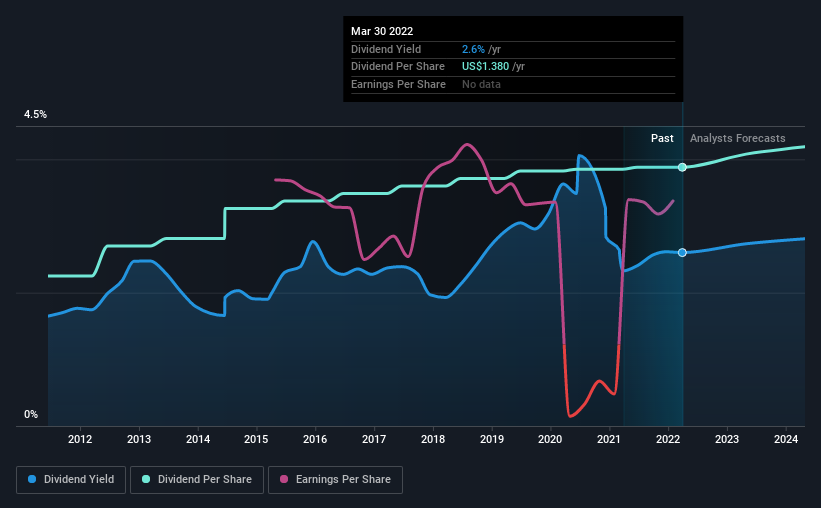Should Income Investors Look At John Wiley & Sons, Inc. (NYSE:JW.A) Before Its Ex-Dividend?
It looks like John Wiley & Sons, Inc. (NYSE:JW.A) is about to go ex-dividend in the next three days. The ex-dividend date is one business day before the record date, which is the cut-off date for shareholders to be present on the company's books to be eligible for a dividend payment. The ex-dividend date is important as the process of settlement involves two full business days. So if you miss that date, you would not show up on the company's books on the record date. Therefore, if you purchase John Wiley & Sons' shares on or after the 4th of April, you won't be eligible to receive the dividend, when it is paid on the 20th of April.
The company's next dividend payment will be US$0.34 per share, on the back of last year when the company paid a total of US$1.38 to shareholders. Looking at the last 12 months of distributions, John Wiley & Sons has a trailing yield of approximately 2.6% on its current stock price of $53.05. If you buy this business for its dividend, you should have an idea of whether John Wiley & Sons's dividend is reliable and sustainable. So we need to check whether the dividend payments are covered, and if earnings are growing.
Check out our latest analysis for John Wiley & Sons
Dividends are usually paid out of company profits, so if a company pays out more than it earned then its dividend is usually at greater risk of being cut. John Wiley & Sons paid out 52% of its earnings to investors last year, a normal payout level for most businesses. A useful secondary check can be to evaluate whether John Wiley & Sons generated enough free cash flow to afford its dividend. Thankfully its dividend payments took up just 32% of the free cash flow it generated, which is a comfortable payout ratio.
It's positive to see that John Wiley & Sons's dividend is covered by both profits and cash flow, since this is generally a sign that the dividend is sustainable, and a lower payout ratio usually suggests a greater margin of safety before the dividend gets cut.
Click here to see the company's payout ratio, plus analyst estimates of its future dividends.
Have Earnings And Dividends Been Growing?
Stocks with flat earnings can still be attractive dividend payers, but it is important to be more conservative with your approach and demand a greater margin for safety when it comes to dividend sustainability. If earnings fall far enough, the company could be forced to cut its dividend. That explains why we're not overly excited about John Wiley & Sons's flat earnings over the past five years. It's better than seeing them drop, certainly, but over the long term, all of the best dividend stocks are able to meaningfully grow their earnings per share. Earnings growth has been slim and the company is paying out more than half of its earnings. While there is some room to both increase the payout ratio and reinvest in the business, generally the higher a payout ratio goes, the lower a company's prospects for future growth.
The main way most investors will assess a company's dividend prospects is by checking the historical rate of dividend growth. John Wiley & Sons has delivered an average of 5.6% per year annual increase in its dividend, based on the past 10 years of dividend payments.
The Bottom Line
Has John Wiley & Sons got what it takes to maintain its dividend payments? Earnings per share have been flat and John Wiley & Sons's dividend payouts are within reasonable limits; without a sharp decline in earnings we feel that the dividend is likely somewhat sustainable. Overall we're not hugely bearish on the stock, but there are likely better dividend investments out there.
On that note, you'll want to research what risks John Wiley & Sons is facing. Case in point: We've spotted 1 warning sign for John Wiley & Sons you should be aware of.
Generally, we wouldn't recommend just buying the first dividend stock you see. Here's a curated list of interesting stocks that are strong dividend payers.
Have feedback on this article? Concerned about the content? Get in touch with us directly. Alternatively, email editorial-team (at) simplywallst.com.
This article by Simply Wall St is general in nature. We provide commentary based on historical data and analyst forecasts only using an unbiased methodology and our articles are not intended to be financial advice. It does not constitute a recommendation to buy or sell any stock, and does not take account of your objectives, or your financial situation. We aim to bring you long-term focused analysis driven by fundamental data. Note that our analysis may not factor in the latest price-sensitive company announcements or qualitative material. Simply Wall St has no position in any stocks mentioned.

 Yahoo Finance
Yahoo Finance 
